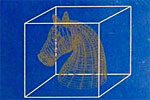


ChessBase 17 - Mega package - Edition 2024
It is the program of choice for anyone who loves the game and wants to know more about it. Start your personal success story with ChessBase and enjoy the game even more.
 Advances in Computer Games 9", edited by Professors H. J. van den Herik, University Maastricht, and B. Monien, University of Paderborn. It was published by the Universiteit Maastricht in 2001. The paper on Cheating was written and submitted by the author in 2000.
Advances in Computer Games 9", edited by Professors H. J. van den Herik, University Maastricht, and B. Monien, University of Paderborn. It was published by the Universiteit Maastricht in 2001. The paper on Cheating was written and submitted by the author in 2000.
Abstract
Nowadays, players at all levels of chess can profit from computer assistance during a game of chess. This is a new development and a serious problem for the game. This contribution lists the main forms of cheating and provides some occurrences from practice. The most prevailing one (Allwermann at the Böblinger Open) is placed in a historical context by describing previously noticed cases of cheating. Finally, the problem of cheating is addressed at the highest level of play. What are the possibilities and how can we prevent cheating at this level? Since there is no clear solution, the problem of cheating remains on the list of issues to be addressed very seriously in the near future.
At the Hoogovens super-tournament in Wijk aan Zee, in January 1999, there was one main topic of conversation. Every morning at breakfast Garry Kasparov would come over to Vishy Anand's table to discuss the matter with him. The object of their interest was the new German chess star, Clemens Allwermann. This hitherto unknown player had won the Böblinger Open, ahead of GMs and IMs. He had played wonderfully courageous attacking chess, scoring 7.5 points from nine games, without a single loss. His Elo performance was 2630. This sensational result made the headlines all over Germany – chess on front pages of straight newspapers.
So who is this Clemens Allwermann? If I said this was a 17-year-old super-sharp kid, rising meteorically, as they sometimes do, you might still find the sheer magnitude of his success difficult to believe. It turns out that Allwermann was 55 years old and had had a stable rating of around 1900 for the last twenty years. He ranked around number 10,000 in Germany, but his remarkable performance could theoretically elevate him to number two (behind Artur Jussupow) in this country.
News of Allwermanns achievement spread quickly – but perhaps not in the way the player himself may have anticipated. “Was a pocket Deep Blue used for brain doping” asked one newspaper, while Der Spiegel put it more sarcastically: “Move over Goethe, Beethoven and Einstein, here comes a new pinnacle of Teutonic genius”.
Nobody was willing to believe that the amateur had done it all on his own. Especially not when other players discovered that you could reproduce virtually all of Allwermann’s moves with the chess program Fritz. All of this was revealed by Hartmut Metz in newspapers and Schachmagazin 64. He gave many examples that show it was not just the tactically brilliant shots played by Allwermann but also bad, anti-positional moves that Fritz will duplicate.
The game that caused the greatest suspicion was the one Allwermann played in the last round. It was an encounter that would decide the winner of the tournament, and the amateur player was facing the leading Grandmaster. Completely undaunted Allwermann proceeded to outplay his opponent in fine attacking style, reaching an easily winning position:
Allwermann,Clemens - Kalinitschev,Sergey (2505) [B32]
Boeblingen op 15th Boeblingen (9), 30.12.1999
1.e4 c5 2.Nf3 Nc6 3.d4 cxd4 4.Nxd4 e5 5.Nb5 d6 6.c4 Be7 7.Be2 a6 8.N5c3 Nf6 9.0-0 Be6 10.Be3 0-0 11.Na3 Nd7 12.Qd2 Nc5 13.Nc2 f5 14.exf5 Bxf5 15.Bf3 Kh8 16.Bd5 Qe8 17.Rad1 Qg6 18.Na3 e4 19.f3 exf3 20.Bxf3 Ne5 21.Nd5 Bh4 22.Nf4 Nxf3+ 23.Rxf3 Qe8 24.Nd5 Ne6 25.Rdf1 Qg6 26.b3 Rf7 27.Nc2 Ng5 28.Bxg5 Bxg5 29.Qf2 Bxc2 30.Rxf7 Bf6
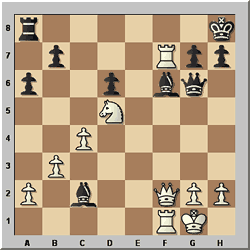
I showed the position to a number of players in Wijk aan Zee, and all gave me simple wins – for instance 31.Rxb7, 31.Rd7 or even 31.Rxf6. Remember, the first time control is looming and tournament victory is in grasp.
So what does our hero play? 31.Qa7?!! “Fritzy!” squealed Anand and went into uncontrollable fits of laughter when he saw this and the following moves (I filmed his mirth and included it in my multimedia report in ChessBase Magazine 69). He and the other players immediately recognised the “hand” of the computer.

If you switch on multiple-variation mode you will see that Fritz thinks 31.Qa7 is a tenth of a pawn better than the other alternatives. A computer program simply doesn't understand the difference between cast-iron moves that cannot fail, and a tight-rope walk on the edge of the precipice. I venture no human would undertake the latter course in the given tournament situation. Play through the continuation and judge for yourself.
31...Rg8 32.Qxb7 Be4. Black is threatening mate on g2, and there is only one move that avoids immediate disaster: 33.Nf4. These are razor-sharp lines, the kind Fritz thrives on. 33...Qf5 34.Qd7 Qe5 35.Kh1 g5. Most human players would now play 36.Nh5 – the knight moves to safety and at the same time attacks an enemy piece. But Fritz and Allwermann cannot be bothered with such timid strategies. 36.Nh3 g4 37.Nf2 Bf5.
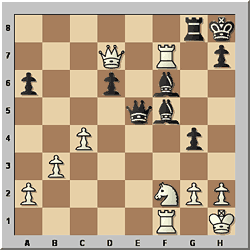
In this position White just needs to move the queen out of the line of attack. He can then sit back and wait for the opponent to stretch out his hand in resignation. But Fritz and Allwermann seek a further escalation of tension: 38.Nxg4. Nerves of steel – or maybe silicon? Cross your heart, is this a move you would play – two moves before the time control, with the overall tournament victory depending on the outcome of this game? 38...Be4 39.R7xf6 Bxg2+ 40.Kxg2 Qe4+ 41.Kh3.
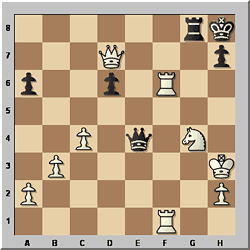
Here Kalinitschev resigned. While they were shaking hands Allwermann couldn't resist mentioning that the final position was mate in eight. “I don't think so,” said Kalinitschev. “Check it out, you'll find I'm right,” replied Allwermann with a wry smile.
Well, some of the more experienced players did exactly that. They switched on their computers and fired up Fritz. The program reacted exactly as Allwermann had done (except perhaps for the smile).

On a PentiumII-400 with 64 MB hash tables Fritz 5.32 finds a mate in nine – you have to deduct the initial black move when you announce it as a mate for White.
I showed the position to a number of players in Wijk – nobody was able to spot the mate. Vishy Anand said that if I had asked him with no prior information he would have guessed it is mate in about fifteen moves. Otto Borik, the editor of Schachmagazin, showed the position to players, including many GMs, at a team championship match. They couldn't find a mate either. Borik tried to work out all the lines. He says they would fill an entire issue of his magazine. Here are some critical variations: 41...Qe8 42.Qf5 Qc8 43.Qf4 a5 (43...Qxg4+ 44.Qxg4 Rxg4 45.Kxg4 Kg7 46.Kh5 a5 47.Rf8 a4 48.R1f7#; 43...Qc5 44.Rf8 Qh5+ 45.Kg2 Qg6 46.Rxg8+ Qxg8 47.Qd4+ Qg7 48.Rf8#; 43...Qe8 44.Rf7 Rg7 45.Qd4 Qe5 46.Nxe5 Rg3+ 47.Kxg3 Kg8 48.Ng6 hxg6 49.Qg7#) 44.Rf7 Rg6 45.Rf8+ Qxf8 46.Qxf8+ Rg8 47.Qxd6 a4 (47...Rxg4 48.Rf8+ and 49.Qf6 mate) 48.Qe5+ Rg7 49.Rf8#. Only Fritz is sure it's mate – after running through 33.117 million positions.
After the Böblinger Open a number of experts also got to work, analysing Allwermann’s games. They all discovered the same thing: on tournament time controls Fritz plays most of the other moves Allwermann executed on the board. There was a lot of speculation on how he might have got the moves from the computer. The tournament director in Böblingen recalls that although the temperature in the playing hall was usually 32 degrees Centigrade Allwermann always appeared with a tie and a dark blazer. Some participants speculated that a miniature camera might have been hidden in his tie. The long hair and spectacles could easily have hidden a receiver. Hartmut Metz reports that Allwermann used to run a store for electronic equipment, so the expertise was probably available.
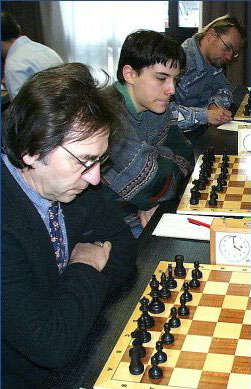 Unfortunately Allwermann talked himself into a corner. Soon after the tournament he published a letter on the Internet saying that his result had been the crowning achievement of a forty year chess career, attributing his play to careful preparation, especially in the Sveschnikov. “I now have a good knowledge of this variation, which I was able to use to defeat GM Kalinitschev in the last round.”
Unfortunately Allwermann talked himself into a corner. Soon after the tournament he published a letter on the Internet saying that his result had been the crowning achievement of a forty year chess career, attributing his play to careful preparation, especially in the Sveschnikov. “I now have a good knowledge of this variation, which I was able to use to defeat GM Kalinitschev in the last round.”
This made it very difficult for him to admit any wrongdoing after the accusations had been raised in the press. He could have conceded he had used a computer, perhaps claiming that it had been his intention to demonstrate an important and dangerous development in chess today, and returned the DM 1660 prize money. Instead he threatened to sue anyone who accused him of cheating – although he didn't follow up when Der Spiegel published their story anyway.
After the articles had appeared in German newspapers and magazines Allwermann wrote a long letter protesting his innocence. Among other things he complained that nobody had published games that would exonerate him. “The second game I played should be of interest to an objective reader. Anyone can see that a computer program would have easily won this game.”
Okay, let’s take a look at it – with Fritz.
Giacopelli,Vincenzo (2145) - Allwermann,Clemens [A46]
Boeblingen op 15th Boeblingen (2), 26.12.1998
1.d4 Nf6 2.Nf3 e6 3.Bg5 c5 4.e3 h6 5.Bxf6 Qxf6 6.Nbd2 cxd4 7.exd4 Nc6 8.c3 d5 9.Bd3 Bd6 10.0-0 0-0 11.Re1 Bd7 12.Nf1 Rac8 13.Ne3 a6 14.Ng4 Qf4 15.h3 Bc7 16.g3 Qd6 17.Qd2 Ne7 18.Nh4 Bb5 19.Bc2 h5 20.Ne5 Be8 21.Qd3 g6 22.g4 f6 23.Nef3 hxg4 24.hxg4 Bf7 25.Qe3 g5 26.Ng2 Kg7 27.Kf1 Rh8 28.Ke2 Qb6 29.Kd2 Ng6 30.Bxg6 Bxg6 31.b3 Rh3 32.Qe2 Rch8 33.Rg1 Be4 34.Nfe1
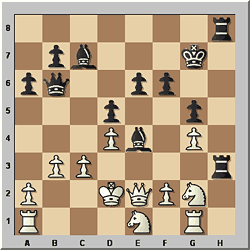
As usual in this tournament Allwermann has outplayed his opponent and is easily winning. Fritz5.32, which reproduces all the moves so far, now shows an evaluation of 4.06 in favour of Black and expects the continuation 34...Bh2 35.f3 Bxg1 36.fxe4 Rxc3 37.Nc2 Bxd4 38.Rc1 Qa5 39.Nxd4–+.
So what does Allwermann play? 34...Bxg2? The wrong bishop! After this move Fritz's evaluation drops by almost four pawns. The game continued 35.Nxg2 Rh2 and a draw was agreed.
There was some speculation as to whether Allwermann was receiving moves in a kind of morse code: dit-dit-dit-dit means “bishop”, dit-dit-dit-dit-dit-dit-dit-dit is h, and dit-dit is two. Oops, did somebody miscount a dit in the above position? Remember, it was round two and things probably had perhaps not settled down yet.
Some months after the event the District Attorney’s office began investigating Allwermann for embezzlement of the prize sum of DM 1,660 – (about $850). GM Rainer Knaak was consulted, and the Fritz expert (Knaak works for ChessBase) confirmed that all the games were almost completely reproducible, move for move, with Fritz5.32 and the Fritz Powerbook '99. Even a small transposition error in the PowerBooks was faithfully reproduced in one of the games. In the meantime Hartmut Metz had located an electronics supplier who had sold Allwermann the equipment he probably used to transmit the computer moves. According to the store owner Allwermann had insisted on a modification that would allow him to enter four-digit codes in the hand-held radio transmitter. He had also purchased the very smallest receiver possible, one that could be completely concealed in his ear and hidden behind his long hair.
However, after many months the DA’s office dismissed the case due to “lack of sufficient proof”. A speaker expressed the view that “moves by good chess players often coincide with those of a computer”, and apart from that there was no direct evidence – nobody had seen or documented the use of electronic devices during the tournament. The Bavarian Chess Federation, on the other hand, took drastic action and barred Allwermann from participation in further tournaments.
Before this was enforced Allwermann had played in one more tournament, closely watched by large numbers of spectators and journalists. He scored exactly what is to be expected of a player who is below the 2000 Elo mark.
– Part four will follow soon –
 |
A history of cheating in chess (1) 29.09.2011 – Hardly a month goes by without some report of cheating in international chess tournaments. The problem has become acute, but it is not new. In 2001 Frederic Friedel contributed a paper to the book "Advances in Computer Chess 9". It traces the many forms of illicit manipulations in chess and, a decade later, appears disconcertingly topical and up-to-date. We reproduce the paper in five parts. |
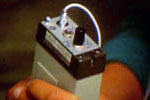 |
A history of cheating in chess (2) 04.10.2011 – Coaching players during the game is probably the most widespread form of cheating (rivaled only perhaps by bribery and the throwing of games). Although this practice began long before the advent of chess playing machines, computers have added a new and dramatic dimension to this method of cheating in chess. You will never guess: who were the pioneers of cheating with computers? |